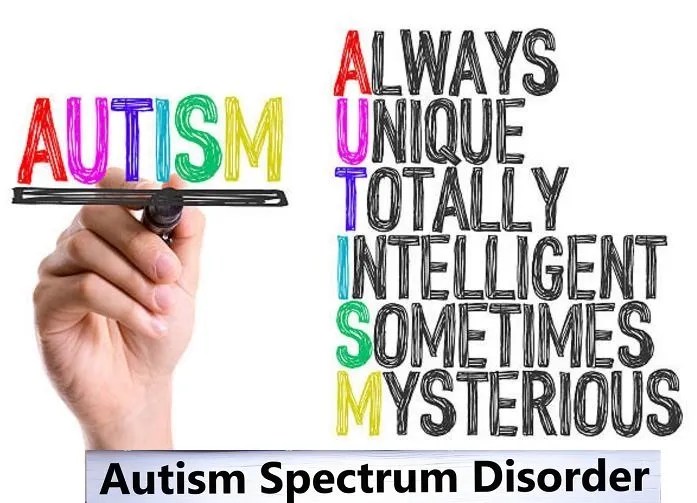
According to American Psychological Association dictionary ASD (also known as Autism or Autism spectrum condition) can be defined as a group of disorders which occurs during the preschool years and characterized by various but often marked difficulties in communication and social interaction skills, but how it is expressed varies. Autism spectrum disorder (ASD) is also a developmental disability which is caused by differences in the brain that can cause significant social, behavioral and communication challenges.
There is usually nothing different about how children or people with ASD look like that sets them apart from others, but people with ASD may communicate, behave, interact, and learn in ways that are different from other individuals. The capability of people with autism spectrum disorder varies significantly. ASD can show up before the age of 3 years and has a possibility of staying throughout a person’s life, although symptoms can improve with time. Most children show Autism spectrum disorder symptoms in less than 12 months of life. In some, ASD may not show up until 24 months or later.
Why AUTISM is called a SPECTRUM DISORDER?
Autism is a called spectrum disorder because the symptoms varies or appears differently for each person, thereby making it difficult to diagnose. It can also be referred to as a wider range of ‘symptoms and severity’. The severity or difficulties that someone with ASD may experience can vary from one person to the next.
AUTISM SPECTRUM DISORDER (ASD) LEVEL
There are 3 different levels of autism spectrum disorder according to diagnostic and statistical manual of mental disorder (DSM-5), the levels are as follows:
- ASD Level 1 (Requiring support)
- ASD Level 2 (Requiring substantial support)
- ASD Level 3 (Requiring very substantial support)
The three different levels assist in knowing how severe the disorder is and to identify the appropriate treatment plan or therapies needed by the patient.
a) ASD LEVEL 1
This level requires support and is the mildest forms of autism because with support they can do better unlike other levels. An individual who meets the criteria for level 1 experience the following challenges in social communication skills:
- They may appear to have decreased interest in social interaction.
- They can speak and communicate but may have little challenge in engaging in a full conversation with people
- Difficulty communicating appropriately with others.
- They may try to make friends but might not be successful.
They may also face challenges in restricted interest and repetitive behavior such as:
- Less difficulty switching between activities
- Problem of organization and planning.
- They may have issues with being independent and trying new things by themselves.
b) ASD LEVEL 2
People with ASD level 2 requires substantial support because of the severity of the disorder at this stage. They experience the following challenges in social communication skills/
a) Social communication skills is always apparent even with support in place.
b) They speak simple sentence and struggle with communication.
c) Marked deficit in verbal and non-verbal social communication skills.
d) Limited initiation of social interactions
e) They may also face challenges in restricted interest and repetitive behavior such as:
- Difficulty changing focus
- Challenge coping with change or other restricted/repetitive behavior(saying the same thing over and over again)
c) ASD LEVEL 3
This is most the severe level of Autism, People with ASD LEVEL 3 requires very substantial support throughout life. The challenges they experience in social communication skills and restricted interests/repetitive behaviors are as follows:
- Very limited initiation of social interaction or communication skills.
- Severe deficits in verbal and non-verbal communication skills causing impairment in functioning(can’t speak clearly)
- Extreme difficulty in coping with change
- Great difficulty changing focus or action
Signs and Symptoms of Autism Spectrum Disorder
Autism is a neurodevelopmental disorder in the brain which causes impairment in social communication and interaction skills, restricted interest and repetitive behaviors. It is important to note that most individuals without ASD might also have some of these symptoms, but for people with ASD it comes with a lot of difficulties thereby affecting their day to day activities. Because ASD appears differently in each child the severity is based on the level of impairment (level 1, 2 and 3) and how they affect the ability to function. Below are common signs which have been show by patients who have ASD (autism spectrum disorder):
SOCIAL COMMUNICATION/INTERACTION SKILLS: Children with autism often face challenges in social communication or interaction skill, which include any of the following signs:
- They cannot respond to name at an early age.
- They cannot show facial expression (sad, angry, happy etc.)at an early age(9months)
- They do not notice when one is hurt or angry at age 2.
- They do not notice the presence of others or join them in playing at age 3.
- They cannot play simple interactive games at 12 months e.g. pat –a-cake.
- They cannot dance, sing or act for you at an early age.
- They are often self-absorbed.
- They have difficulty in developing language skills and most times can’t understand what people say to them.
- Difficulty in understanding body language.
- They usually avoid eye contact which often makes them seem rude.
- They may seem aggressive in an attempt to communicate their needs, thoughts, or feelings.
RESTRICTED INTEREST AND REPETITIVE BEHAVOUR: Examples of such behaviors as related to autism spectrum disorder are as follows:
- They can’t speak clearly
- They get emotional (angry) by little changes.
- They always follow a particular way or pattern of doing things.
- They repeat the same words or sentence over and over again, this is called echolalia
- They stay focused or stare at a particular object for a very long time.
- They play with things the same way all the time
- They react in an unusual way to things, sounds, looks etc.
- They say things that have no meaning or does not relate to the current conversation.
- They often cause self-harm to them self’s such as biting any part of their body.
5 CHARCTERISTICS RELATED TO PEOPLE WITH ASD
People with Autism spectrum disorder have the following related characteristics:
- Delayed speech or communication skills
- Delayed movement or coordination(walking on toes, clumsiness)
- Delayed learning skills
- They show Inattentive, hyperactive and impulsive disorder like ADHD
- Digestive problem such as constipation.
Early diagnosis and intervention can be very helpful, there are different treatment program but the best begins early at preschool. Also note that people without ASD can have some the above symptoms, but such symptoms with ASD patients can be very challenging.
Causes of Autism in Adults and Children
Autism is a developmental disorder which is caused by differences in the brain. It can be noticed very early in childhood, the level of severity varies, it can be characterized by impaired communication skills, social skills and repetitive behavior. Scientists do not know the exact cause of autism spectrum disorder. The disorder is complex and no two individual with autism are alike, although the cause of autism spectrum disorder can be known in some patients, GENETICS ,ENVIROMENT AND BIOLOGY are very important factors to consider in autism. Challenges during child birth, or having infection during pregnancy are factors that can increase the risk of a child having ASD DISORDER. Autism is more common in men male than female people with Down syndrome, fragile x syndrome and tuberculosis are more likely to have autism.
GENETIC/BIOLOGICAL FACTORS AS A MAJOR CONTRIBUTION OF ASD DISORDER
According to research genetic factors have been estimated to contribute 40 to 80 percent of ASD risk, the genes associated with autism are in the development of the brain. Protein produced from gene affects the different aspects of the brain development, production, organization and growth of nerve cells (neurons) are also included. Some of the proteins affect the quantity of neurons that are being produced. Scientists indicated that in brain development, some individuals with ASD DISORDER have higher neurons than normal and an over growth in some parts of the outer surface (cortex) of the brain. The cortex has six layers which are developed before birth, the layers have specialized neurons and the neural connection patterns are usually different. Abnormalities of the brain usually occurs in the cortex (frontal and temporal lobe), which are involved in social communication or behavior, emotions and speech or language skills.
If a family member has autism spectrum disorder there is every possibility to have a child who has the disorder in essence knowing your family health history is very important. If you’re planning to get pregnant or your already pregnant its vital you tell your doctor if you or your partner have an ASD history because early diagnosis and screening is important to ensure proper treatment and management plan. Family health history information includes: parents (both couples parents),brothers, sisters ,aunties, uncles, nephew, nieces, children you and your partner, also include anyone who has been diagnosed but is no longer in use such as mental retardation, Asperger syndrome. Always share your family health history of autism with your children’s doctor. The most common test for people with autism spectrum disorder is called CHROMOSOMAL MICROARRAY (CMA) the test checks chromosomes to find out if there are missing parts or extras that could cause ASD, genetic testing and counselling are important to help the child and family have a proper understanding of the test results, it also gives the doctor useful information on how to treat your child with ASD. Specialist your doctor might refer your child to if there is a developmental delay are;
a) Child Neurologists or Pediatric Neurologist: They treat children from birth who have problem with their nervous system such as brain, nerves or muscles such problems can lead to developmental delay.
n) Child psychologists or psychiatrists: They help treat social, behavioral, emotional and mental health of children and adolescents.
c) Developmental pediatricians: They specialize child development.
Environmental Causes of Autism
Environmental factors associated with autism before and during birth are as follows:
- Exposure to air pollution.
- Maternal factors and prenatal conditions.
- Pesticides, metals and other contaminant.
- Nutrition
a. EXPOSURE TO AIR POLLUTION
Scientist found out that prenatal exposure to air pollution might be a risk factor for autism. Mothers living close to a freeway, traffic related pollution during their third trimester of pregnancy are likely to develop autism spectrum disorder. Children with a mutated gene called MET and high levels of exposure to air pollution might have increased risk of the disorder (ASD).
b. MATERNAL FACTORS AND PRENATAL CONDITIONS
When there is an issue with a mothers immune system, metabolic conditions or inflammation during pregnancy it may be linked with higher autism risk for the child. Some mothers with autistic children usually have proteins or antibodies in the body that can fight infection, which may affect their child’s brain development and possibly lead to autism. Maternal obesity or diabetes can increase the possibility of giving birth to a child with autism or other developmental disorder. Also having fever during pregnancy can increase the risk of autism for children.
c. PESTICIDES METALS AND OTHER CONTAMINANT
Exposure of prenatal or early childhood to mercury, lead or altered levels of metals like manganese or zinc , pesticides and other contaminants can increase the risk of autism in a child. Scientist study of twins used the baby teeth to compare and determine the levels of manganese, lead and zinc in children with autism and children without autism. ASD children were very low on zinc and manganese which are very important to life but had a high level of lead, which is very harmful during a specific developmental time. According to research maternal exposure to different insecticides during pregnancy can be associated with a high risk of autism spectrum disorder in children.
d. NUTRITION
Taking prenatal vitamins can help reduce the risk of autism in children. In addition taking supplements and vitamins often provides protective effects for individuals who are exposed to environmental contaminants during pregnancy. Folic acid is a good source of prenatal vitamins, studies have shown that women who took the daily recommended dosage during their first trimester of pregnancy had a low risk of having an autistic child also pregnant women who used multivitamins with iron or folic acid were less likely to have children with intellectual disability or autism spectrum disorder.
Types of ASD Treatments
Autism spectrum disorder (ASD) treatment seeks to reduce symptoms that interfere with an individuals daily functioning and quality of life. Autism affects children differently, meaning that ASD patients have unique strengths ,challenges and different treatment needs. Therefore, treatment plans usually involve multiple professionals and the main goal of treatment is to help the child function by reducing ASD symptoms and support learning and development.
Early childhood intervention in preschool can help the child learn critical social, functional, communication and behavioral skills. There are home based and school based treatment and intervention for ASD, most times it can be overwhelming because the child needs may change over time.
When people with ASD graduate from high school and grow into adulthood, additional services can assist in improving their health, and daily functioning promotes social and community engagement. For some, assistance to continue education, complete job training, get employed, secure housing and transportation may be needed. Professional treatment options for Autism spectrum disorder may include the following:
- Behavioral and communication therapy
- Education and school based intervention
- Pharmacological Approach
- Developmental Approach
- Psychological Approach
A) Behavioral and Communication Therapy
Some programs are focused on addressing language (speech), social and behavioral challenges associated with autism spectrum disorder. Behavioral therapy is focused on changing the child’s behavior by having a deep understanding of what happens before and after the behavior. Behavioral therapy have the most evidence for treating Autism spectrum disorder symptoms. It is widely accepted by healthcare professionals and educators, it is used in schools and treatment clinics. A known behavioral treatment for individuals with autism is called Applied Behavior Analysis (ABA). ABA encourages a child to learn new skills, desired behaviors and discourages negative behaviors to promote a variety of skills and this can be achieved through a reward based motivation system. Various types of applied behavior analysis used to treat autism include:
- Positive Behavior and support (PBS): This method focuses on why the child behaves in a particular way different from the norm. PBS works to improve the environment and teach positive skills.
- Pivotal Response Training (PRT): This takes place in a natural setting or the child’s day to day environment. The purpose is to improve the child PIVOTAL SKILLS that would help the child learn many more skills and manage situations. According to Vismara & Bogin, 2009 PRT builds on children motivation and interests, and is effective for communication, imitation, language, joint attention, play and social skills development.
- Discrete Trial Training (DTT): In DTT instruction are broken down in to simpler parts and positive behaviors and desired answers are always rewarded while negative behaviors and answers are ignored. Discrete trial training uses a step by step procedures to teach a desired behavior.
b) Education and School Based Intervention
Educational therapy are usually applied in a classroom setting. Education and school based intervention helps a child improve their communication, sensory, motor and behavioral skills, it also reduces disruptive behaviors. Education helps to promote educational potential in individuals or children with disabilities. 2 types of educational approach are:
-Treatment and Education of Autistic and Related Communication-Handicapped Children (TEACCH): This was developed by the University of North Carolina and is used basically for Autism Spectrum Disorder, it uses structured teaching method to achieve unique learning needs of children with ASD. Principles of TEACCH are:
-Physical structure: There should be an environment and boundaries set for each task.
-Consistent schedule: Always schedule the activities for the day. This can be achieve through verbal and non-verbal communication, pointing or drawing of the Childs daily needs.
-Establishment of expectation: The child should be taught how to do things independently without major assistance from people.
-Visual based cues: When dealing with ASD daily activities can be written or drawn and placed in clear sight.
Individualized Education Program (IEP): This special education team gives you a specialist who would work with your child in their school.
Pharmacological Approach
There are medications that treat some co-occurring symptoms that help people with ASD function better at school, church or home etc. Such medications can help manage high energy levels or hyperactivity as found in ASHD, in ability to focus on a particular object or thing and self-inflicted injuries such as hand biting and head banging. Medication helps improve psychological conditions such as depression, also medical challenges such as insomnia, seizures or gastrointestinal issues. Lastly for the benefit of the child and guardian ensure to use the service of a doctor who is experienced in treating children with autism disorder when opting for medication.
Developmental Approach:
This approach is focused on promoting developmental, physical or language skills, this approach can also be combined with behavioral therapy. Speech and language therapy is the most common developmental approach.
Psychological Approach:
Psychology contributes greatly to the management and treatment of ASD. This approach helps people with autism spectrum hyperactive disorder cope with depression, anxiety (psychotherapy can be used in managing anxiety) and other mental issues. Cognitive Behavior Therapy also known as CBT is another approach that is focused on learning the relationship between feelings, thoughts and behaviors. Other areas that are helpful for Autism Spectrum Disorders are listed below:
- Play therapy
- School/educational psychology
- Drama therapy
- Family psychology
WHAT IS ASPERGER SYNDROME?
Asperger syndrome is a neurodevelopmental disorder which causes impairment in communication, social and language skills along with repetitive thought and behavior pattern. Asperger syndrome is now defined as an Autistic disorder.
SYMPTOMS OF ASPERGER SYNDROME
- They experience trouble with social interactions.
- They engage in repetitive behavior.
- They always focus on rules and routines.
- Restricted interest.
- They have difficulty in coordination.
CAUSES OF ASPERGER SYNDROME
- It might be hereditary
- When a prenatal is exposed to toxic elements it can cause Asperger syndrome.
- Abnormalities in the brain
- Excessive prematurity.
TREATMENT OF ASPERGER SYNDROME
- Cognitive and behavioral therapy(CBT)
- Language and speech therapy
- Antidepressants
- Antipsychotic drugs.
In conclusion, this article covers a wider and grey areas in ASD, the term which is now used to describe a wide range of autism spectrum disorder especially amongst children.
I hope this helps, please feel free to ask questions via the comment section below, should you have any.




